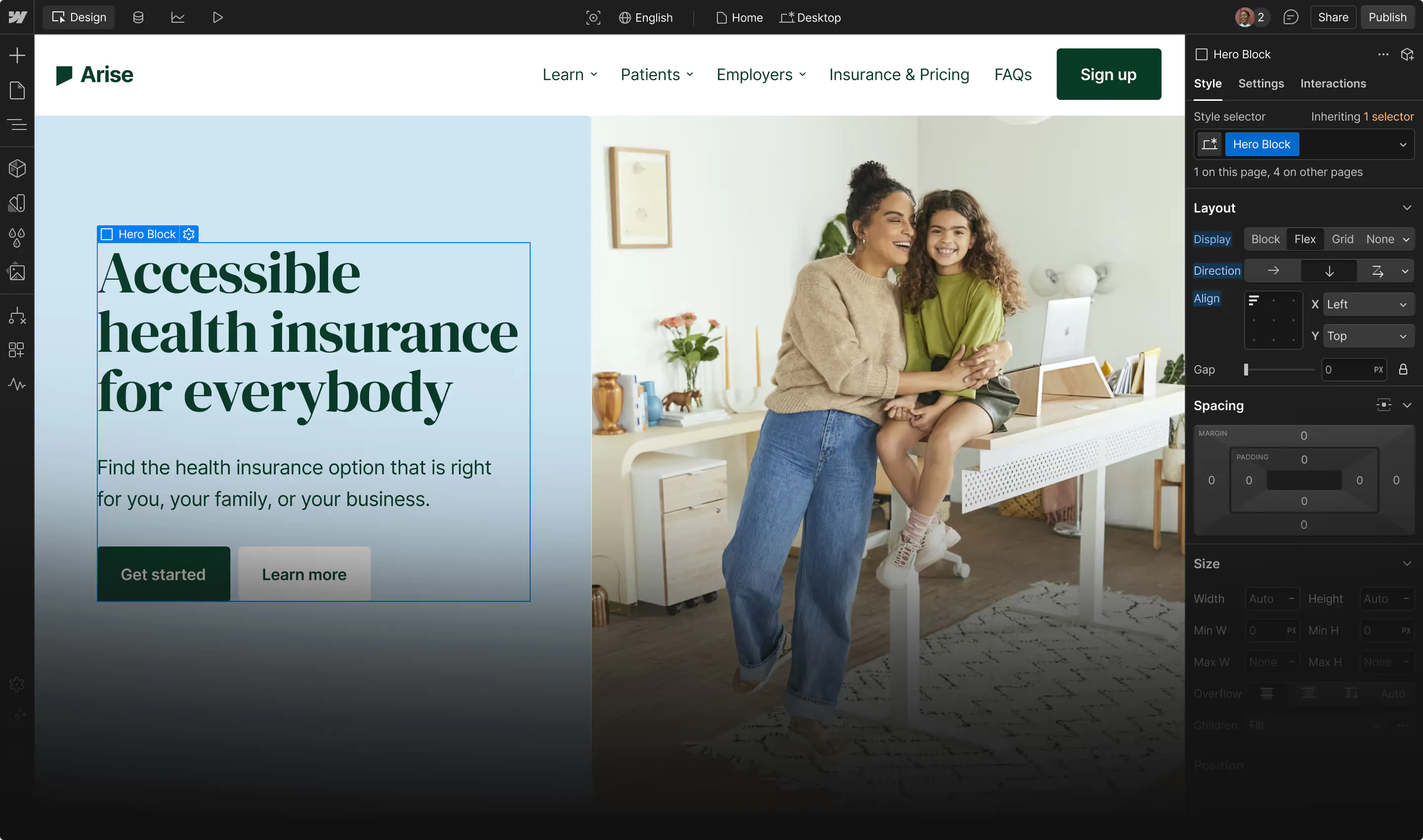Effectively leveraging data can be a complex endeavor for today’s marketers.
"A lot of times, data is too fragmented or siloed or hard to access," explains Caroline Ren, Product Marketing at Webflow. This resonates with marketing teams everywhere who are drowning in data yet struggling to turn it into meaningful action.
At Webflow Conf, industry leaders from Microsoft and Webflow came together to tackle a pressing question: How can marketing teams transform the wealth of website analytics into strategic action?
The discussion showed that while companies have more data than ever before, the real challenge lies not just in collecting information, but in making it accessible, understandable, and actionable across organizations.
"The first big problem is data overload," notes Ravi Theja Yada, Director of Product at Microsoft Clarity. "We've made it easy to instrument and gather data, but being able to analyze that data is really difficult." This complexity is compounded by the global nature of modern business, where understanding user behavior across different regions and cultures can be difficult.
Still, amid these challenges lies opportunity.
Forward-thinking marketing teams are discovering that when data insights are democratized across organizations (from designers to content creators to developers), it transforms from a specialized tool into a universal language for making better decisions. This shift isn't just about having better analytics—it's about changing how teams approach website optimization, creative development, and customer experience.
Below, we'll learn how to build a data-driven marketing practice that drives real business outcomes while maintaining creative excellence. From establishing effective review cadences to balancing data with brand expression, we’ll uncover practical frameworks for turning website analytics into marketing wins.
Breaking down data overload
Modern marketing teams face a paradox: they have more data than ever before, yet struggle to extract meaningful insights. "There's just so much data now," explains Yada. "You have so many different tools to get data, whether it's analytics tools, A/B testing tools, customer feedback, form input tools...It's hard to pinpoint which ones you should look at, which ones you should prioritize."
This abundance of data leads to fragmentation across multiple platforms and teams. As Caroline Ren from Webflow mentions, "Performance marketers are living in these tools every single day—they're not only experts in the tools, this is their job." However, this specialization can create silos, where critical insights stay locked away from the teams who need them most.
For web strategists and designers, the primary barrier isn't the complexity of the data itself. It's simply gaining access to it. Teams often find themselves negotiating priorities without the data needed to make informed decisions. As Ren explains: "If they didn't have that data to be able to push back on me and my asks, then we would just be sitting there spinning. Whoever has the loudest opinion or is the most senior person ends up getting their way, and that's really not the best way to work."
The solution revolves around giving the right data accessible to the right people at the right time. This is non-negotiable for global organizations trying to understand user behavior across different regions and cultures. "You're not able to kind of get that sense of feeling of how a user in Estonia might be feeling about your website versus a user down the street from you," Yada points out.
Leading organizations are addressing these challenges by:
- Consolidating analytics tools to reduce redundancy
- Creating centralized dashboards accessible to all team members
- Implementing tools that bring analytics directly into existing workflows
- Focusing on metrics that directly tie to business outcomes
Building a high-impact data practice
When it comes to building an effective data practice, Microsoft Clarity's team has identified two distinct approaches among their most successful users. "I think of Clarity customers as in two major buckets: the solvers and the explorers," explains Yada.
- Solvers: Trying to solve specific problems
- Explorers: Trying to proactively improve customer experiences
"The solvers," he elaborates, "are coming in because they have a specific problem or specific initiative—like 'I'm launching this new thing and I need to make sure that everything looks good' or 'I have a really low conversion rate on my signup page, how do I improve it?'" These teams use data tactically to address immediate challenges and optimize specific metrics.
The "explorers," on the other hand, take a more proactive approach. "These are the people that tend to become more customer-obsessed," says Yada. "They're trying to understand where are the friction points in my experience, and how do I bring those down."
Establishing the right review cadences
Really, the key to sustained success is turning data analysis into a regular practice. "We've had customers that say this is their weekly meeting," Yada shares. "They have a weekly meeting where the product team, design team, engineering sit together for an hour and they look at sessions, they look at heat maps together. It's almost like doing a user study at scale all the time."
This structured approach guarantees that insights don't just live in dashboards but become part of the team's decision-making process.
As for the recommended cadence: "I would recommend trying to do this on a weekly or bi-weekly cadence at the least," advises Yada, "to understand what customers are actually feeling about your experience."
Creating cross-functional alignment
One of the most powerful outcomes of a strong data practice is its ability to align different teams around objective insights. Ren highlights how this plays out in practice: "Sometimes we're negotiating which web pages should I prioritize...I can give you a laundry list of, say, 25 pages that need to be updated or need to be stood up, but only have the resources available to do 10 of them before launch day."
In these scenarios, data becomes the arbiter. Teams can make informed decisions about priorities based on actual user behavior and business impact rather than opinions or assumptions. These practices help organizations move beyond sporadic data usage to create a culture where insights drive continuous improvement.



















Start using Analyze today
Webflow Analyze puts a native, unified view of visitor behavior into the hands of designers and content marketers — so you can make data-backed decisions that improve site performance.
Balancing data and brand expression
The relationship between data and creativity often sparks debate in marketing teams.
"Fundamentally all the creatives that I've spoken to agree that data should be helping you understand what's performing and what's not performing to help you refine your creative approach," Ren explains. "It should not dictate your creative approach and it should not turn your creative approach into something bland and utilitarian."
One of Webflow's copywriters crystallized this balance perfectly, Ren shares: "Data helps me know what works and what doesn't work, but creativity helps you stand out as a brand." This perspective highlights how data and creativity can work in harmony rather than opposition.
A great example of this balance comes from Masters of Scale, a popular podcast that uses Microsoft Clarity. As Yada describes: "They have Clarity running on their site and they were running these new AI podcasts that they really wanted to drive traffic through. They just looked at the scroll heat map and saw that the majority of the customers actually aren't even getting to that point. So all they did was move that module up and they saw a tremendous increase in engagement."
Using data to challenge assumptions
Perhaps most importantly, data can help challenge personal biases and assumptions that might limit creativity. "A lot of times when we feel really strongly about something, we don't think about what is actually driving that opinion," Ren notes. This is particularly helpful when designing for different markets and cultures.
She illustrates this with a practical example: "If I'm US-based, and I'm making decisions on an Asia website based on my design best practices and my intuition...okay, keep it really sleek and minimalistic. Asian websites…they like really crowded visuals and things like that, though. So again, [data] just checks you, even when you have a really strong opinion."
Ultimately, the goal isn't to let data override creative intuition—rather, it’s to create a feedback loop that helps teams understand what resonates with their audience while maintaining brand distinctiveness. Used this way, data becomes a tool for refinement rather than restriction.
Making the business case
Creativity is fine and dandy, but future investments in website development and optimization are often tied to concrete results. No results, no investment.
"The performant piece is ultimately the part that's going to create more resourcing and more opportunity to build more websites," explains Greg Kelly, Senior Business Development Manager at Webflow. "You do want to have the data in your back pocket if you're in a design or development role so that you can make the business case as to why more website development is important for the team."
For agencies, data has become a powerful tool in strengthening client relationships and expanding services. Ren highlights a growing trend among agency partners: "There's a clean handoff where you do a project and hand it off to a client, and then there's these retainer-type projects where you have opportunities to add hours every single time your client needs an update. Having proactive analytics to be able to inform when those opportunities are is amazing."
Agencies are finding that data-driven insights help them:
- Justify strategic recommendations
- Demonstrate the impact of their work
- Identify opportunities for optimization
- Build stronger retainer relationships
Turn your data into action
As you’ve heard, successful website optimization isn't just about collecting data—it's about making that data accessible, actionable, and integral to your team's workflow. Whether you want to improve your data practice or just kickstart your analytics journey, here’s how you can start doing more with your data.
First, connect your Webflow site to an analytics platform. Try Webflow Analyze, a native analytics solution that puts unified visitor behavior data directly into the hands of designers and content marketers. Analyze helps your teams access site and page insights right within Webflow to make it easier than ever to make data-backed decisions.
When you want deeper behavioral insights, turn to Microsoft Clarity in the Webflow Marketplace. This free tool helps teams understand exactly how visitors interact with their sites with features like heatmaps and sessions recordings.
With the right data practice and the right tools, you’ll be on the right path toward making strategic, data-informed, actionable marketing decisions for your organization.
































